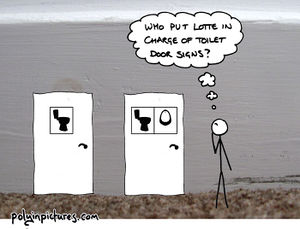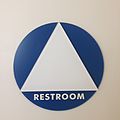Public toilets
Public toilets are a serious challenge for nonbinary, intersex, or gender nonconforming people. Places that only offer men's or women's restrooms create an unsafe situation where gender nonconforming people have to choose between potentially getting harassed or assaulted, or having to wait so long that they get health problems. A single-occupancy, gender-neutral restroom is safest, so it is important for everyone's rights to be able to find these spaces, and to ask for them to be created in public places that need to have them.
Problems[edit | edit source]
Restrooms for able-bodied people are often assigned to male and female, with little to no provision for people who don't fit the gender binary. For nonbinary and gender nonconforming people, having to choose whether to go in a men's room or women's room can be a source of social anxiety and gender dysphoria. People who are seen as gender nonconforming may be subjected to harassment, violence, or arrest if others think they have entered the wrong restroom. Because of these risks, some people try to avoid using public toilets by waiting so long that it is bad for their health. Health risks from waiting too long to use a toilet include urinary stones, dehydration, cystitis, and infections of the bladder and kidneys.[1] Another health concern is being able to wash one's hands in order to prevent the spread of contagious diseases.
- Go Where? is an article on the gendering of public toilets, looking into the visual symbols and what they say about language and public perception of gender.
- "Renaming the bathrooms: A cruel trick for queer ends," by androgyne Raphael Carter regarding a practical joke about signs on restroom doors, providing some levity about these issues.
Advocating for gender-neutral restrooms[edit | edit source]
There has long been a common misconception that having separate restrooms for men and women helps prevent assault. However, facts don't support this assumption.[2] For preventing assault, a single-occupancy restroom is more effective. There is no reason for a single-occupancy restroom to be only for a certain gender. A gender-neutral, single-occupancy restroom makes public places safer for everyone.[1]
Most public places only offer baby changing tables in the women's room, which can be a problem for fathers, and for any other caretaker who feels out of place in a women's room. Caretakers of babies, children, or other dependents want gender-neutral, single-occupancy restrooms. People who have disabilities want accessible, single-occupancy restrooms. Transgender, nonbinary, intersex, and gender nonconforming people can unite with these groups to organize and advocate for these improved public restrooms more effectively.[3]
These are some resources for people who want there to be gender-neutral restrooms in public places.
- Transgender Law Center. (2005). Peeing in peace: A resource guide for transgender activists and allies. https://web.archive.org/web/20160505212347/http://transgenderlawcenter.org/issues/public-accomodations/peeing-in-peace
- Sylvia Rivera Law Project (Producer) & Mateik, T. (Director). (2003). Toilet training: Law and order in the bathroom (DVD). United States: Silvia Rivera Law Project.
Finding gender-neutral restrooms[edit | edit source]
How to find gender-neutral public toilets anywhere, and how to handle situations where these aren't available.
- Refuge Restrooms is a replacement for Safe2pee. It also has an iOS app available.
- Safe2pee is a crowdsourced world map of public toilets that are gender-neutral and/or accessible. There is an iPhone app that uses the information so that you can find places when you're out and about, called Transquat.[Dead link]
Restroom signs[edit | edit source]
In some public places, where the facilities are already adequate, something as simple as the signs on the restroom doors can make a difference in whether people feel safer there. Some kinds of signs are more effective at this, and others make matters worse.
These kinds of signs have disadvantages:
- "Family restroom" signs can be seen as excluding people who are not being a caretaker of babies, children, or other dependents at that moment. Sometimes people who are by themselves get told they are not allowed to use them.
- Urinal signs that are only on restroom doors that have urinals can seem like a solution for making restrooms gender-neutral without changing the facilities in them. However, they can still be used to single out people who are expected to be able to pee standing up. People end up treating them as if they were still labeled as a men's room. As one trans woman, eva embers, said that a urinal sign "becomes an opportunity to out me, make assumptions about my genitals, essentialize my gender according to my birth sex, and push me into the men’s room."[4] In her experience, urinal signs did not reduce sex discrimination against her.
- A transgender symbol is not a familiar symbol to everyone, and is not an international pictogram for a restroom. Restrooms need to be marked with an international pictogram, so that people who do not read the local language can recognize them without having to ask for help.
- Heart or moon symbols are traditional for outhouse doors in the Western world, but they are not common on public restroom signs. Maybe they should be, but at this point, they would be less recognizable as a restroom sign than human figure pictograms.
- Joke restroom signs can poke fun at cultural assumptions about gender. However, some such signs have jokes on them that are transphobic or are about sexual assault. Those make public restrooms feel less safe, and they reflect badly on the opinions of the management, and whether you could go to the management for help. Joke restroom signs can act as a conversation-starter that can be a set-up for harassment. Even a tasteful joke on a restroom sign can make it harder for people who do not read the local language to recognize that this is the door to the restroom.
These kinds of signs have advantages:
- Pictograms of human figures are the most internationally recognized symbols for restrooms. It's familiar and effective to see unisex bathrooms marked with just two figures, the standard male and female pictograms. Three figures-- male, female, and a figure that is a mixture of both-- help clarify that these are not the only two genders, and that people who are gender nonconforming are welcome. Some unisex restrooms are marked with a single figure that is a mixture of both male and female pictograms. This mixed figure is based on the split costume from a Victor-Victoria burlesque stage act, which is maybe not the best choice for representing real people who are gender nonconforming, nonbinary, or intersex.
- A pictogram of a baby or a baby changing table can be helpful to mark on a restroom door, where applicable.
- "Unisex" is okay and common, so it is more recognizable to more people.
- "Gender neutral" is okay.
- "Gender inclusive restroom" is okay, but the wording is relatively less recognizable to people who are less proficient in reading this language.
- "All gender restroom" is the best caption, because it helps challenge the popular misconception that there are only two genders, and it's in wording that is recognizable even to people who are less proficient in reading this language.
These are some examples of what various kinds of gender-inclusive restroom signs look like, showing their advantages and disadvantages.
A bathroom sign in Sweden, with rainbow pattern and transgender symbol to indicate inclusivity.
Further reading[edit | edit source]
- Fogg Davis, Heath (2017). "Why the "transgender" bathroom controversy should make us rethink sex-segregated public bathrooms" (PDF). Politics, Groups, and Identities. doi:10.1080/21565503.2017.1338971. Archived from the original (PDF) on 17 July 2023.
See also[edit | edit source]
References[edit | edit source]
- ↑ 1.0 1.1 Laura Erickson-Schroth, ed. Trans Bodies, Trans Selves: A Resource for the Transgender Community. Oxford University Press, 2014. P. 576.
- ↑ Fogg Davis, Heath (2017). "Bathroom Bouncers: Sex-Segregated Restrooms". Beyond Trans: Does Gender Matter?. New York University Press.
- ↑ Laura Erickson-Schroth, ed. Trans Bodies, Trans Selves: A Resource for the Transgender Community. Oxford University Press, 2014. P. 473.
- ↑ eva embers (May 1, 2014). "Here is what happens". Skysquids (blog). Archived from the original on August 23, 2014.




















